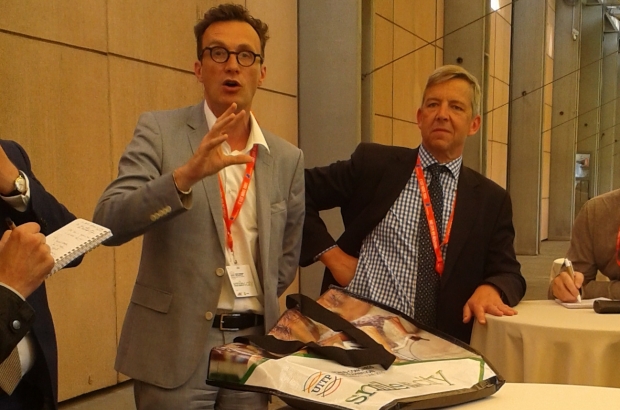- Daily & Weekly newsletters
- Buy & download The Bulletin
- Comment on our articles
Electric dreams: exploring the future of public transport in Brussels
Electric mega-buses that hold almost 200 passengers in comfort. Wifi and phone charging points at every tram stop and on every tram. Paying for tickets with a swipe of your smartphone. It’s already becoming reality in cities around the world, and Brussels is eyeing up the future of its own public transport system.
Mobility minister Pascal Smet and representatives of the city’s public transport system Stib/MIVB were in Milan last week for the biannual conference hosted by UITP, the international association for public transport. Smet and Stib CEO Brieuc De Meeûs (pictured above) talked of seeking inspiration from other cities that could help transform Brussels.
Public transport is essential, they said, as a way of making a city more liveable, for those who live there and those who travel there, whether for work or leisure. We won’t see these transformations immediately, but together the Brussels region and Stib “are committed to diving in to the future of public transport”.
One focus of the conference was electric vehicles – extra-long articulated buses, trams that run with no need for overhead cables, 24-hour charging that’s silent and practically instantaneous – the development of electric vehicle technology means a world of opportunities is opening up to the people who design and implement our public transport systems.
Speakers from Moscow, Bogotá, Geneva, Singapore and elsewhere presented their city’s vision of transport that’s environmentally sustainable and good for society too. In Gothenburg this month, Volvo launched its first fully electric bus, which can travel 1km for every rotation of a 2MW wind turbine, while Milan itself has just opened the newest station on its fully automated metro line.
Fully automated
Stib’s aim is to have Brussels’ extended tram line 3 fully automatic by 2024, from Albert in the south to Bordet in the north. These lines gain seconds at each stop, automated platform gates prevent people crossing the tracks or dropping objects on the line, and unexpected passenger volumes can be managed easily by adding extra trains at short notice.
The end of Milan’s new line 5 is the San Siro football stadium, where turnstiles regulate the numbers of people allowed to enter the metro station. This post-match crowd management is something that currently presents a challenge at Brussels’ own Heysel stadium.
Tickets can already be paid for by contactless credit card at the gates of the London Underground, while in Norway, smartphone ticketing counted for more than three million purchases in the first nine months after its introduction. And a simple, analogue approach has helped tackle fare dodging in Dijon and Melbourne: in Melbourne, simplifying the range of tickets and making them easier to buy cut fare dodging in half, while passengers repeatedly caught without tickets in Dijon are offered the option of paying a fine equivalent to the price of a year’s travel pass – or just buying a year’s travel pass.
Alain Flausch, the head of UITP in Brussels, pointed out that it’s our duty for the next generation to make life in big cities as pleasant as possible. Whatever the future of mobility, he said, mass transport remains the answer. For Stib, the challenge is to find new ways of successfully integrating public transport into our lives.



















Comments
When are they going to replace the wretched metro trains on lines 2/6 (which, let's be truthful, is only one line). They are a disgrace - filthy and ugly.